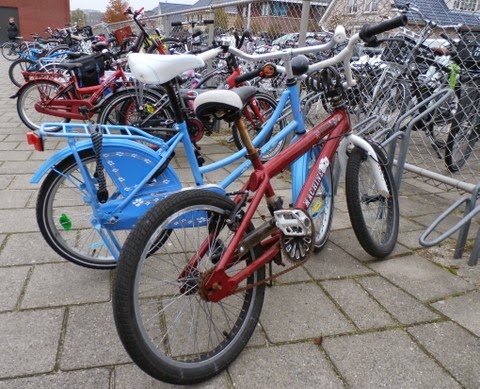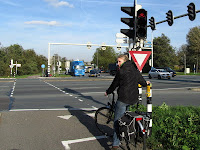In the latest Get Britain Cycling Report, Berno points out that the Dutch not only have well designed cycling infrastructure, but that the Dutch have better bicycles too. In his view, this is a vital missing component in the drive to get the British people to use bicycles more often. Below a slightly edited version of Berno's article, as published in the report. To illustrate the article, we've put all pictures of British bikes on the left and Dutch bicycles on the right; enjoy!
Going Dutch, All The Way: The missing link
Over the past 30 years the British have either stuck to their drop handle tourers or adopted the mountain bike as a general bicycle. Meanwhile, the Dutch have been developing their bikes to a fantastic standard. How the UK has completely missed out on these developments remains a mystery to me. Most bicycles ridden in the Netherlands are designed and built there as well. About half a dozen manufacturers are competing for their share of a critical buying public, and this has driven them to excellence.

Look at the picture above; which bicycle is fit for purpose for your child to cycle to school; the red BMX "British-style" or the blue Dutch bike immediately behind it?
Look at the picture above; which bicycle is fit for purpose for your child to cycle to school; the red BMX "British-style" or the blue Dutch bike immediately behind it?
There is a pressing need for the pro-cycling campaign to widen its agenda to include the bicycles themselves. I don’t have the wherewithal myself to introduce better bicycles into the UK on the scale needed, but I sense a golden opportunity for someone, somewhere. It would improve the situation in Britain in various, important ways.
Let’s imagine that the Dutch type hybrid did become widely available, allowing bicycling that did not involve sport and speed. Lots of people cycling in a stable, upright position while having a good view of their surroundings would result in friendlier, safer environment.
Berno Brosschot, "Cycling Dutchman" in Llŷn, Wales. Find Berno on Facebook or send him an email to find out more about Dutch hybrid bikes.
 Berno is not the only "Cycling Dutchman" who noticed the lack of Dutch-style hybrid bikes in other countries. Cycling Dutchman Meindert Wolfraad lives in Australia and developed his own Lekker Bikes brand. His bike designs bring a a fresh twist to the Dutch-style hybrids, getting popular in Australia and New Zealand!
Berno is not the only "Cycling Dutchman" who noticed the lack of Dutch-style hybrid bikes in other countries. Cycling Dutchman Meindert Wolfraad lives in Australia and developed his own Lekker Bikes brand. His bike designs bring a a fresh twist to the Dutch-style hybrids, getting popular in Australia and New Zealand!
If you live in the UK and wish to purchase a new quality Dutch bike, pay a visit to the Dutch Bike shop in Littlehampton or Flying Dutchman Bike in London.
 Cycling in Amsterdam and The Netherlands - The very best routes in the cyclist's paradise makes you travel beyond Dutch cliches like clogs, windmills and the Amsterdam red light district, allowing you to truly explore the lowlands. The book features 1064 kms of routes and has special chapters explaining the unique Dutch cycling-minded traffic rules and its cycle route signage systems; 164 pages, colour, wiro bound, fits in standard handlebar bag, see also http://www.cyclinginholland.com.
Cycling in Amsterdam and The Netherlands - The very best routes in the cyclist's paradise makes you travel beyond Dutch cliches like clogs, windmills and the Amsterdam red light district, allowing you to truly explore the lowlands. The book features 1064 kms of routes and has special chapters explaining the unique Dutch cycling-minded traffic rules and its cycle route signage systems; 164 pages, colour, wiro bound, fits in standard handlebar bag, see also http://www.cyclinginholland.com.


Cycle paths and cycle lanes; the full story!
Sharing the road or segregated cycle paths? Well it is both!

If you live in the UK and wish to purchase a new quality Dutch bike, pay a visit to the Dutch Bike shop in Littlehampton or Flying Dutchman Bike in London.
What about going for a ride on a Dutch hybrid with one of our "Cycling Dutchman" guidebooks?


The London - Land's End Cycle Route Book is designed for those who LOVE cycling, but don't like traffic. The book takes you onto the most beautiful cycle routes of southern England, including the Camel Trail, Devon Coast to Coast Route, Bristol and Bath Railway path, Thames Valley route and many more! What makes the book unique is that the route is completely continuous, including detailed directions and local knowledge all the way. Get inspired; choose your favourite route sections or go for a full summer holiday adventure; 164 pages, colour, wiro bound, fits in standard handlebar bag, £ 15.99, see also http://www.london-landsendcycleroutebook.com.
Other popular Cycling Dutchman blog articles:
Other popular Cycling Dutchman blog articles:
Explaining Dutch cycling infrastructure:
Cycle paths and cycle lanes; the full story!
Sharing the road or segregated cycle paths? Well it is both!
Bicycleandtour.com on helmets


 Dutch style bike rides in the United Kingdom:
Dutch style bike rides in the United Kingdom:
London by bicycle: The East-West Cycle Route
From Bristol into the Somerset Levels
Cycling around the English Channel
An international cycling holiday with toddlers
Other popular Cycling Dutchman blog articles:
Explaining Dutch cycling infrastructure:

London by bicycle: The East-West Cycle Route
From Bristol into the Somerset Levels
Cycling around the English Channel
An international cycling holiday with toddlers